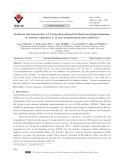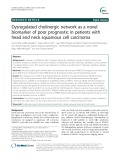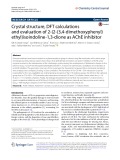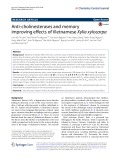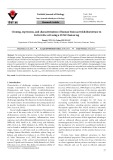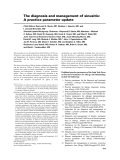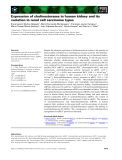
Cholinergic system
-
Part 1 book "Rang and Dale's pharmacology" includes content: How drugs act, how drugs act, how drugs act, how drugs act, cell proliferation, apoptosis, repair and regeneration, cellular mechanisms, method and measurement in pharmacology, absorption and distribution of drugs, drug metabolism and elimination, pharmacokinetics, individual variation, pharmacogenomics and personalised medicine,... and other contents.
 413p
413p  muasambanhan05
muasambanhan05
 22-01-2024
22-01-2024
 4
4
 2
2
 Download
Download
-
Cancer cells express immunosuppressive molecules, such as programmed death ligands (PD-L)1 and PD-L2, enabling evasion from the host’s immune system. Cancer cells synthesize and secrete acetylcholine (ACh), acting as an autocrine or paracrine hormone to promote their proliferation, differentiation, and migration.
 20p
20p  visharma
visharma
 20-10-2023
20-10-2023
 6
6
 2
2
 Download
Download
-
The discovery of enzyme targeting inhibitors is a popular area of drug research. Biological activities of the compounds bearing phenol and heteroaryl groups make them popular groups in drug design targeting important enzymes such as acetylcholinesterase (AChE, E.C.3.1.1.7) and carbonic anhydrases (CAs, EC 4.2.1.1). The compounds 2 and 4 were found potent AChE inhibitors with the Ki values of 22.13 ±1.96 nM and 23.71 ±2.95 nM, respectively, while the compounds 2 (Ki = 8.61 ±0.90 nM, on hCA I) and 1 (Ki = 8.76 ±0.84 nM, on hCA II) had considerable CAs inhibitory potency.
 10p
10p  tudichquannguyet
tudichquannguyet
 29-11-2021
29-11-2021
 10
10
 1
1
 Download
Download
-
Epithelial-mesenchymal transition (EMT) has been proposed as a mechanism in the progression of airway diseases and cancer. Here, we explored the role of acetylcholine (ACh) and the pathway involved in the process of EMT, as well as the effects of mAChRs antagonist.
 11p
11p  vimontana2711
vimontana2711
 05-04-2021
05-04-2021
 9
9
 1
1
 Download
Download
-
In airways, a proliferative effect is played directly by cholinergic agonists through nicotinic and muscarinic receptors activation. How tumors respond to aberrantly activated cholinergic signalling is a key question in smoking-related cancer.
 13p
13p  vialabama2711
vialabama2711
 21-09-2020
21-09-2020
 13
13
 1
1
 Download
Download
-
Dioxoisoindolines have been included as a pharmacophore group in diverse drug-like molecules with a wide range of biological activity. Various reports have shown that phthalimide derivatives are potent inhibitors of AChE, a key enzyme involved in the deterioration of the cholinergic system during the development of Alzheimer’s disease.
 9p
9p  vijiraiya2711
vijiraiya2711
 27-05-2020
27-05-2020
 20
20
 1
1
 Download
Download
-
Alzheimer’s disease (AD) is the most common cause of dementia among the elderly and is characterized by loss of memory and other cognitive functions. An increase in AChE (a key enzyme in the cholinergic nervous system) levels around β-amyloid plaques and neurofibrillary tangles is a common feature of AD neuropathology.
 10p
10p  vijiraiya2711
vijiraiya2711
 27-05-2020
27-05-2020
 16
16
 1
1
 Download
Download
-
Two theories attempt to explain the changes observed in the nicotinic acetylcholine receptors (nAChRs) in chagasic cardiomyopathy. The neurogenic theory proposes that receptor changes are due to loss of intracardiac ganglia parasympathetic neurons.
 9p
9p  vienzym2711
vienzym2711
 03-04-2020
03-04-2020
 9
9
 2
2
 Download
Download
-
The molecular structure of acetylcholinesterase (AChE) attracts interest because of its versatility and significant role in the cholinergic system. The main purpose of the present study was to clone a full-length cDNA sequence of human brain acetylcholinesterase (hAChE) into pET SUMO vector and express it successfully.
 11p
11p  nutifooddau
nutifooddau
 27-01-2019
27-01-2019
 41
41
 2
2
 Download
Download
-
(bq) part 1 book "pharmacology for health professionals" presentation of content: foundations of clinical pharmacology, drugs that affect the central nervous system, drugs that affect the peripheral nervous system.
 262p
262p  thangnamvoiva23
thangnamvoiva23
 06-10-2016
06-10-2016
 42
42
 6
6
 Download
Download
-
(bq) part 1 book "medical pharmacology at a glance" presents the following contents: principles of drug action, drug absorption, distribution and excretion, drug metabolism, local anaesthetics, autonomic nervous system, autonomic drugs acting at cholinergic synapses, drugs acting on the sympathetic system, ocular pharmacology,... and other contents.
 46p
46p  thangnamvoiva23
thangnamvoiva23
 06-10-2016
06-10-2016
 54
54
 7
7
 Download
Download
-
Sympathetic nerve stimulation induces vasoconstriction and consequent decreases nasal airway resistance. Parasympathetic nerve stimulation on the other hand, promotes secretion from nasal airway glands and nasal congestion. The nasal mucosa also contains nerves of the non-adrenergic, non-cholinergic (NANC)- system. Neuropeptides from the latter nerves (substance P, neurokinin A and K, and calcitonin gene-related peptide) are suspected to play a role in vasodilatation, mucus secretion, plasma extravasation, neurogenic inflammation, and mast cell nerve interactions.
 35p
35p  nhacnenzingme
nhacnenzingme
 28-03-2013
28-03-2013
 79
79
 4
4
 Download
Download
-
Despite the aberrant expression of cholinesterases in tumours, the question of their possible contribution to tumorigenesis remains unsolved. The identifica-tion in kidney of a cholinergic system has paved the way to functional studies, but details on renal cholinesterases are still lacking. To fill the gap and to determine whether cholinesterases are abnormally expressed in renal tumours, paired pieces of normal kidney and renal cell carcinomas (RCCs) were compared for cholinesterase activity and mRNA levels....
 11p
11p  viettel02
viettel02
 19-02-2013
19-02-2013
 31
31
 1
1
 Download
Download
-
Seven distinct antigenic botulinum toxins (BNT-A, -B, -C, -D, -E, -F, and -G) produced by different strains of Clostridium botulinum have been described. The human nervous system is susceptible to five toxin serotypes (BNT-A, -B, -E, -F, -G) and unaffected by 2 (BNT-C, -D). Although all toxins have different molecular targets, their action leads to the blockade of the cholinergic nerves. However, only the A and B toxins are available as drugs.
 92p
92p  camchuong_1
camchuong_1
 10-12-2012
10-12-2012
 51
51
 5
5
 Download
Download
-
Abstract Glucose homeostasis in humans is an important factor for the functioning of nervous system. Hypoglycemia and hyperglycemia is found to be associated with central and peripheral nerve system dysfunction. Changes in acetylcholine receptors have been implicated in the pathophysiology of many major diseases of the central nervous system (CNS). In the present study we showed the effects of insulin induced hypoglycemia and streptozotocin induced diabetes on the cerebellar cholinergic receptors, GLUT3 and muscle cholinergic activity. Results showed enhanced binding parameters and gene...
 9p
9p  toshiba23
toshiba23
 18-11-2011
18-11-2011
 53
53
 2
2
 Download
Download
-
Table 54-14 Causes of Urticaria and Angioedema I. Primary cutaneous disorders A. Acute and chronic urticariaa B. Physical urticaria 1. Dermatographism 2. Solar urticariab 3. Cold urticariab 4. Cholinergic urticariab C. Angioedema (hereditary and acquired)b II. Systemic diseases A. Urticarial vasculitis B. Hepatitis B or C infection C. Serum sickness D. Angioedema (hereditary and acquired) a A small minority develop anaphylaxis. b Also systemic. The common physical urticarias include dermographism, solar urticaria, cold urticaria, and cholinergic urticaria.
 5p
5p  konheokonmummim
konheokonmummim
 30-11-2010
30-11-2010
 69
69
 5
5
 Download
Download
-
Acetylcholine is a widespread chemotransmitter in the body, mediating a broad range of physiological effects.There are two distinct classes of receptor for acetylcholine defined on the basis of their preferential activation by the alkaloids, nicotine (from tobacco) and muscarine (from a fungus, Amanita muscaria). Cholinergic drugs (acetylcholine agonists) mimic acetylcholine at all sites although the balance of nicotinic and muscarinic effects is variable.
 15p
15p  bigbaby87
bigbaby87
 03-09-2010
03-09-2010
 62
62
 5
5
 Download
Download
CHỦ ĐỀ BẠN MUỐN TÌM










